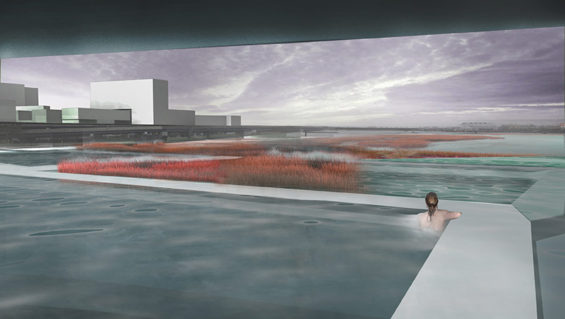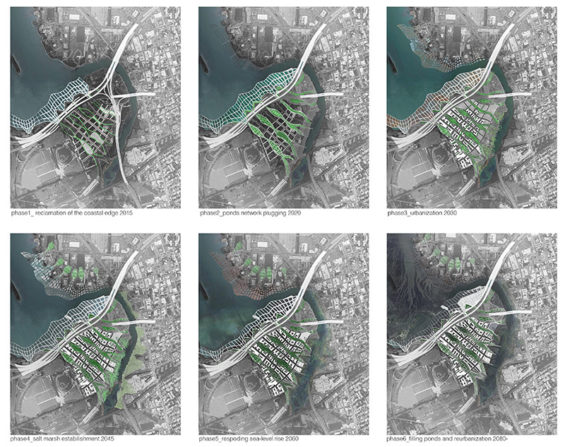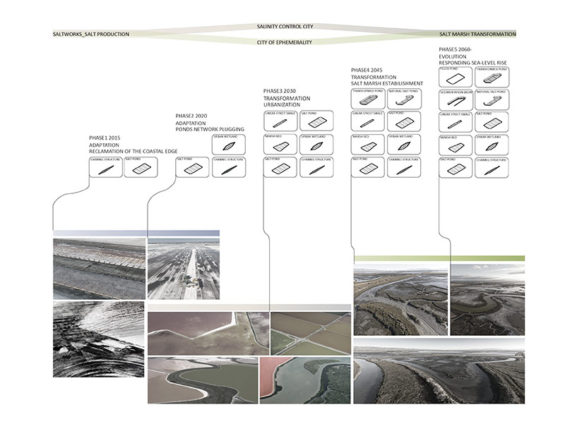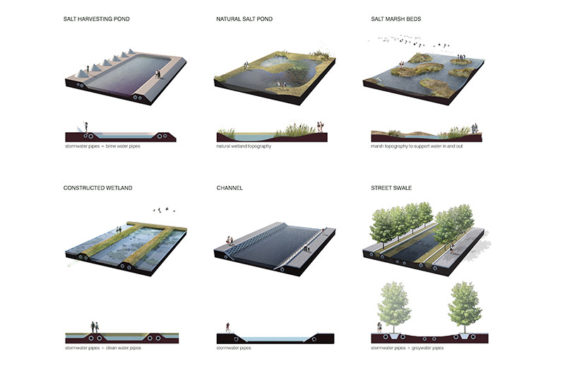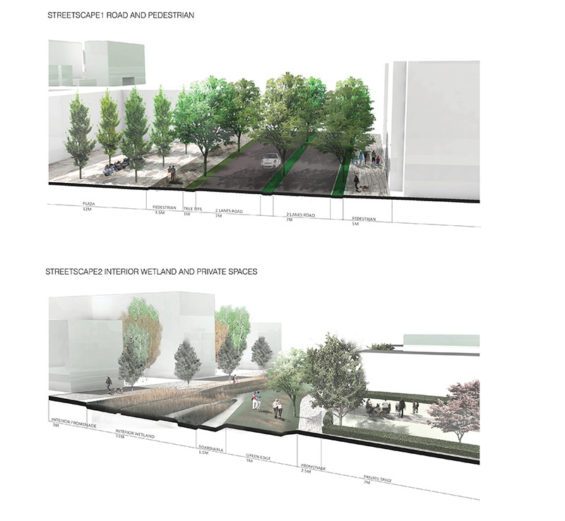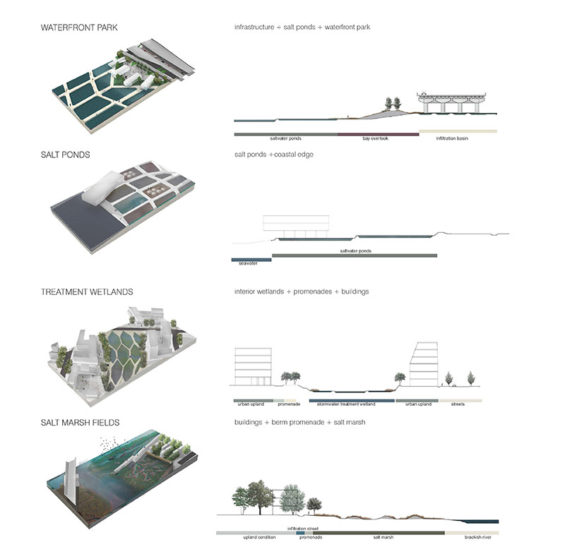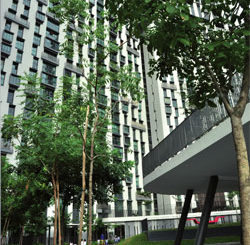Flushing Saltworks envisions to create flexible and ecological urban form –a landscape based urbanism- on the horizon of Flushing Bay in New York City. Employing morphology and performance of saltwork ecologies, the site is fabricated with fluid urban fabrics and pond typologies to integrate urban hydrology and estuarine ecology. The transition of coastal horizon proposes phenomenal atmospherics of the salt ponds and marshes, adapting tidal force and sea level rise. Thus, the project manifests new horizon which evolves into the flexible city, blurring the edge of the coastal shoreline, dissolving the hardened urban formation and creating ephemeral and porous lifestyle.
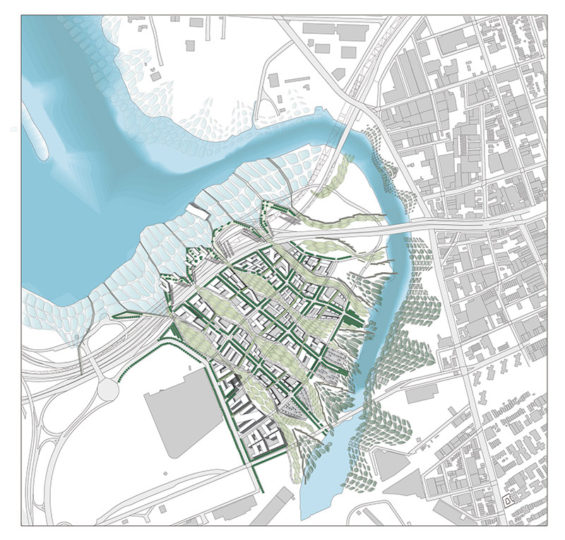
The site, Willets Points is located at the estuary of Flushing Bay in New York City with the highly complicated context: fabricated by massive transportation infrastructures; Two overwhelming highways, and La Guardia Airport; the wide range of adjacent urban fabrics from medium-rise communities in Flushing Downtown, low-rise chop-shop industrials in Willets Points to a large scale cultural complex and open space – Citi Fields Stadium, Flushing Meadows Corona Park. Moreover, the site has been exposed to seasonal fluctuation in the flow of Flushing River, and to tidal dynamics of the bay area. And even more, the bulk-headed coastal edge is vulnerable to potential sea level rise in the future. In this context, the site is on the point between huge infrastructures, complex urban settings, and the ecology of the estuary. How can landscape weave these complicated conditions to evolve into the sustainable and ecological city?
Saltworks as a productive ecology has been on the intersection between the nature of tidal force and the culture of production. In order to reform the coastal line, the saltworks ecology proposes resilient, adaptive, and flexible edge conditions, responding ecology of tidal force and sea level rise in the future with its fluid morphologies and ecological operation. Morphing pond structures, six pond typologies are designed for operating integration of urban hydrology and estuarine ecology; Salt pond, marsh bed, treatment wetland, infiltration basin, channel, and street swale.
Phasing strategies arise from ecological process and transformation of the estuary with the saltworks ecology. Responding to tidal flow, the shift of water direction, and dynamic changes of salinity level, a network fabricated by pond typologies reforms the coastal edge of Willets Points. First part of phasing is reclamation of the edge with salt ponds and channels. The intervention begins from northern part of the site for the initial creation of salt fields. Shifting ponds’ morphology, those are plugged into the upland of Willets points. The ponds network frames urban blocks and infrastructures as a landscape spine. The spines perform not only as controlling integrated hydrologic system, collecting and treating stormwater, but also as used for main public corridors. The density and programs of buildings are organized by the scale and performance of interior pond structures. Building typologies are generated to give flexible occupation to the pond networks eventually to propose ‘porosity’ with the relation of interior landscape and the coastal edge. After restructuring urban forms, the salt ponds and marsh beds propagate along the coastal area inside Flushing Bay and the river. These whole processes will respond from the sea-level rise, creating ecological but high-urban conditions. As one of feasible scenarios, when the sea-level will get higher than proposed salt-ponds elevation, the edge will be transformed from salt ponds to salt marsh condition with a process of tidal flat ecology or can be shifted to the urban platform flexibly.
The operation of hydrology control begins from intensive water-managing system and results in very natural processes of estuarine ecology and coastal dynamics. Controlling different water salinity types such as stormwater, saltwater, and brackish is a key for this operation. The stormwater in urban area are collected block by block. The street structures are designed in order to infiltrate run-off water at the center of the road and alongside pedestrians. It is collected in the interior treatment wetland that consists on the landscape spine mainly. Water flows through a series of the wetlands remediating contaminants from urban and goes into the channel for discharging itself to Flushing bay and simultaneously cleaning bittern water generated from the process of salt production. This self-remediation hydrologic system operates to amplify sustainability of salt ponds and interior ponds network and relieve urban salinity derived from chemicals in stormwater. Responding sea-level rise, this salinity control system will be shifted to one way which direction is from the bay area to the river. Flow of tidal water will be dominant on the site through the interior landscape, facing flushing river. After this moment, interior treatment wetlands will be transformed to the salt marshes and channels, adapting elevated sea-level. The hydrologic condition will be saline and brackish resulting in different types of ecological conditions.
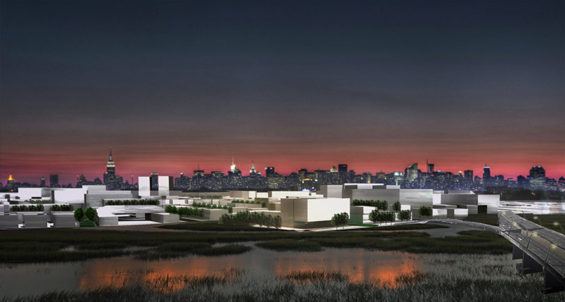
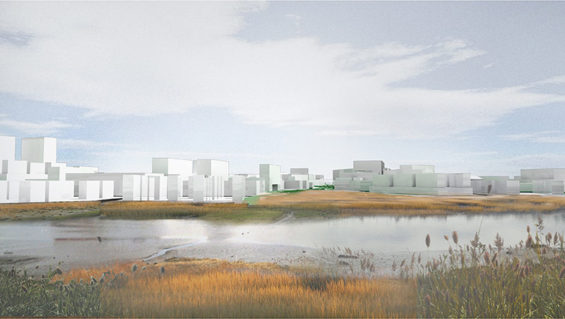
Beyond the operations, the reformed horizon proposes distinctive experiential and phenomenal atmospherics to the visitors and dwellers. Salt ponds have dynamic visual qualities based on seasonal changes with its as well as performative characteristics. People can experience the whole transition of transformation from the salt-fields into the natural estuary as time goes by In the urban area, ponds network gives vibrant public amenity with a mosaic of private and semi-private spaces. On the gleaming horizon, Willets Points will evolve into the flexible city, blurring the edge of the coastal shoreline, dissolving the hardened urban formation and creating ephemeral and porous lifestyle.
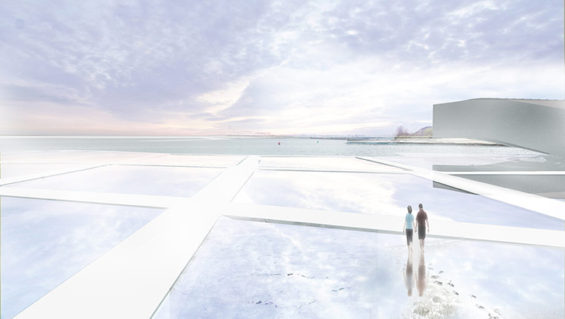
Flushing Saltworks: Reforming the Coastal Horizon, Queens, New York
Designer | Taehyung Park
Image & Text Credit | Taehyung Park
Note: click diagrams for larger image

